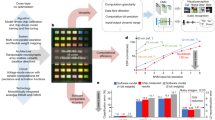Abstract
The recent decades have given advent to the rise of sophisticated High Performance Computing (HPC) accelerators, vastly speeding up calculations. In the last years dedicated AI accelerators, meant for the evaluation of Artificial Neural Networks, have gathered traction. Resistive Random Access Memory (RRAM) devices are a possible future candidate for these accelerators since crossbar implementations allow for the evaluation of matrix vector multiplications in \(\mathcal {O}(1)\). Unfortunately integrating these novel devices into accelerators challenges since they still suffer from device variations and require sophisticated peripheral circuitry. Additionally, suitable design flows are missing since these cells are difficult to integrate into the traditional digital flow. While multiple foundries are able to fabricate promising RRAM prototypes suffering less from device variations, full system integration tends to be lacking. Fortunately the rise of the RISC-V ecosystem has enabled eased access to a fully customizable ISA. We propose to exploit the advantages of the RRAM devices combined with the flexibility of RISC-V cores by integrating multiple RRAM-based blocks into a RISC-V core via Memory Mapped I/O (MMIO), resulting in an architecture which can be reconfigured in software. Additionally, we propose a possible approach for the design, simulation and verification of large RRAM systems, namely setting up three closely intertwined simulation environments and illustrate its applicability by integrating, characterizing and validating a RRAM-based MVM block fabricated in 130 nm technology. Finally, we demonstrate that RRAM technologies might be ready for HPC.
Access this chapter
Tax calculation will be finalised at checkout
Purchases are for personal use only
Similar content being viewed by others
Notes
- 1.
Leibniz-Institut für innovative Mikroelektronik.
References
Asanovic, K., et al.: The rocket chip generator. EECS Department, University of California, Berkeley, Technical report UCB/EECS-2016-17 4 (2016)
Asanović, K., Patterson, D.A.: Instruction sets should be free: the case for RISC-V. EECS Department, University of California, Berkeley, Technical report UCB/EECS-2014-146 (2014)
Damian, M., Oppermann, J., Spang, C., Koch, A.: SCAIE-V: an open-source scalable interface for ISA extensions for RISC-V processors. In: Proceedings of the 59th ACM/IEEE Design Automation Conference, pp. 169–174 (2022)
Fritscher, M., et al.: Mitigating the effects of RRAM process variation on the accuracy of artificial neural networks. In: Orailoglu, A., Jung, M., Reichenbach, M. (eds.) SAMOS 2021. LNCS, vol. 13227, pp. 401–417. Springer, Cham (2022). https://doi.org/10.1007/978-3-031-04580-6_27
Greengard, S.: Will RISC-V revolutionize computing? Commun. ACM 63(5), 30–32 (2020)
Hu, M., Li, H., Chen, Y., Wu, Q., Rose, G.S., Linderman, R.W.: Memristor crossbar-based neuromorphic computing system: a case study. IEEE Trans. Neural Netw. Learn. Syst. 25(10), 1864–1878 (2014)
Kermarrec, F., Bourdeauducq, S., Badier, H., Le Lann, J.C.: LiteX: an open-source SoC builder and library based on Migen Python DSL. In: OSDA 2019, Colocated with DATE 2019 Design Automation and Test in Europe (2019)
Milo, V., et al.: Accurate program/verify schemes of resistive switching memory (RRAM) for in-memory neural network circuits. IEEE Trans. Electron Devices 68(8), 3832–3837 (2021)
Perez, E., Zambelli, C., Mahadevaiah, M.K., Olivo, P., Wenger, C.: Toward reliable multi-level operation in RRAM arrays: improving post-algorithm stability and assessing endurance/data retention. IEEE J. Electron Devices Soc. 7, 740–747 (2019)
Peters, C., Adler, F., Hofmann, K., Otterstedt, J.: Reliability of 28nm embedded RRAM for consumer and industrial products. In: 2022 IEEE International Memory Workshop (IMW), pp. 1–3. IEEE (2022)
Shafiee, A., et al.: ISAAC: a convolutional neural network accelerator with in-situ analog arithmetic in crossbars. ACM SIGARCH Comput. Archit. News 44(3), 14–26 (2016)
Strohmaier, E., Meuer, H.W., Dongarra, J., Simon, H.D.: The TOP500 list and progress in high-performance computing. Computer 48(11), 42–49 (2015)
Truong, M.S., et al.: RACER: bit-pipelined processing using resistive memory. In: MICRO-54: 54th Annual IEEE/ACM International Symposium on Microarchitecture, pp. 100–116 (2021)
Various: Spike RISC-V isa simulator. https://github.com/riscv-software-src/riscv-isa-sim (2023)
Various: VexRiscv RISC-V implementation. https://github.com/SpinalHDL/VexRiscv (2023)
Wang, Y.E., Wei, G.Y., Brooks, D.: Benchmarking TPU, GPU, and CPU platforms for deep learning. arXiv preprint arXiv:1907.10701 (2019)
Xia, L., Gu, P., Li, B., Tang, T., Yin, X., Huangfu, W., Yu, S., Cao, Y., Wang, Y., Yang, H.: Technological exploration of RRAM crossbar array for matrix-vector multiplication. J. Comput. Sci. Technol. 31(1), 3–19 (2016)
Yu, S., Guan, X., Wong, H.S.P.: On the switching parameter variation of metal oxide RRAM-part II: model corroboration and device design strategy. IEEE Trans. Electron Devices 59(4), 1183–1188 (2012)
Zhu, L., et al.: Heterogeneous 3D integration for a RISC-V system with STT-MRAM. IEEE Comput. Archit. Lett. 19(1), 51–54 (2020)
Zou, X., Xu, S., Chen, X., Yan, L., Han, Y.: Breaking the von Neumann bottleneck: architecture-level processing-in-memory technology. Sci. China Inf. Sci. 64(6), 160404 (2021)
Acknowledgement
This work was supported in parts by the BMBF by the Federal Ministry of Education and Research (BMBF, Germany) in the Projects iCampus II (Project No. 16ES1128K), KI-PRO (Project No. 16ES1002), KI-IoT (Project No. 16ME0092), HEP (Project No. 16KIS1339K) and 6G-RIC (Project No. 16KISK026). The authors gratefully acknowledge the scientific support and HPC resources provided by the Erlangen National High Performance Computing Center (NHR@FAU) of the Friedrich-Alexander-Universität Erlangen-Nürnberg (FAU). The hardware is funded by the German Research Foundation (DFG). The authors would also like to thank Tim Henkes (Hochschule RheinMain) for creating the Vexriscv layout and Frank Vater (IHP) for continuous support.
Author information
Authors and Affiliations
Corresponding author
Editor information
Editors and Affiliations
Rights and permissions
Copyright information
© 2023 The Author(s), under exclusive license to Springer Nature Switzerland AG
About this paper
Cite this paper
Fritscher, M. et al. (2023). Prototyping Reconfigurable RRAM-Based AI Accelerators Using the RISC-V Ecosystem and Digital Twins. In: Bienz, A., Weiland, M., Baboulin, M., Kruse, C. (eds) High Performance Computing. ISC High Performance 2023. Lecture Notes in Computer Science, vol 13999. Springer, Cham. https://doi.org/10.1007/978-3-031-40843-4_37
Download citation
DOI: https://doi.org/10.1007/978-3-031-40843-4_37
Published:
Publisher Name: Springer, Cham
Print ISBN: 978-3-031-40842-7
Online ISBN: 978-3-031-40843-4
eBook Packages: Computer ScienceComputer Science (R0)



